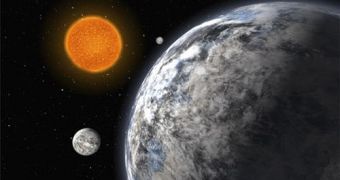There is no reason why other rocky planets in the universe should not be able to support life, but a considerable amount of time will pass before a planet such as our own is found in the galaxy, mostly because of its relatively small size. So far, a couple of hundred of planets have been discovered by astronomers, orbiting around other stars, most of which are gas giants. Just recently, the latest technological advancements have enabled the detection of several tens of super-Earths as well, leading researchers to the inevitable question of whether these particular giants fulfill the right conditions for life to emerge.
"There's no reason why the different chemical cycles that are important for life on our planet wouldn't work on super-Earths," says Lisa Kaltenegger of the Harvard-Smithsonian Center for Astrophysics, co-organizer of the latest conference session regarding this subject. Because some of these super-Earths orbit so close to their host stars, not only are they extremely hot but they are also tidally locked to them, similarly to our Moon, which always shows only one face towards our planet.
This tends to suggest that, while one side experiences extremely high temperatures, the opposite side would be completely frozen, preventing the formation of an atmosphere, as hot gas is pushed to the cold side where it freezes on the surface. However, recent models show that, in fact, an atmosphere can be supported if heat convection is taken into consideration, triggering air circulation patterns that warm the cold side. At the same time, the side facing the star is being cooled by air coming from the other side.
It would seem that the models imply that even when a planet orbits its star from a distance of only 0.05 astronomical units, it could still be able to create some of the conditions required for the appearance of life. Additionally, astronomers say that this unique type of system could even have more chances of supporting life than smaller rocky planets orbiting farther away from their stars, such as Earth and Mars. While Earth appears to hold a rather fortunate and privileged position in the solar system, Mars on the other hand is too far away, therefore too cold to support liquid water on the surface.
"The way we have experienced life on Earth is enabled by plate tectonics," says Harvard graduate student Diana Valencia.
The molten cores of giant rocky planets should provide with the sufficient heat to keep the tectonic plates moving on top of the mantle and, at the same time, with an easier mechanism for heat convection. This is because plate tectonics tend to be much thinner in comparison with the size of the planet and because they slip beneath and atop of each other with relative ease.
"But there's going to be a lot of super-Earths discovered before that. If we're concerned about finding life, those are the planets we should be investigating right now," she said.

 14 DAY TRIAL //
14 DAY TRIAL //